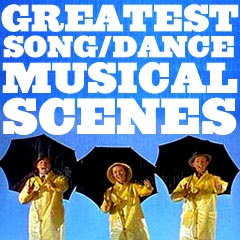
|
|
| B (continued) | ||
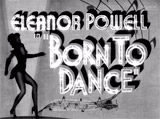
|
Born to Dance (1936) In this MGM film about a low-key romance, Eleanor Powell (as aspiring Broadway dancer Nora Paige in her first starring role) was again directed by Roy Del Ruth. The film featured many musical compositions by Cole Porter (his first score written directly for the screen). Sailor-on-leave Ted Barker (James Stewart in his sole musical film) met Nora and sang the delightful Easy to Love (pictured) to her as they strolled in a Central Park setting. After they kissed, she responded with a song and then (after another kiss) a lyrical dance, while Ted conducted an imaginary orchestra. A Central Park policeman (Reginald Gardiner) took over, launching into a wild impression of a wild-haired symphony maestro (a spoof of conductor Leopold Stokowski) as he directed the imaginary orchestra in a combination of Ponchielli's Dance of the Hours and Easy to Love. By the end of the number, the policeman/conductor keeled over in a dead faint. And later, on an Art Deco rooftop, Broadway star Lucy James (Virginia Bruce) (dubbed) sang the classic melodic standard, I've Got You Under My Skin (pictured) to an embarrassed Ted. There was also a great dance number with most of the film's stars, for the song Hey, Babe, Hey! (I'm Nuts About You) (pictured). The final grand production number, with a nautical motif on board the deck of an Art Deco battleship with three giant cannons, was Swingin' the Jinx Away (pictured) - it featured a tap-dancing Eleanor Powell with a military band. |
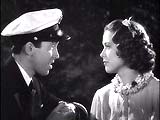     
|
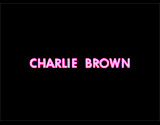
|
A Boy Named Charlie Brown (1969) This was the first (and best of four) animated theatrical feature film that starred Charles M. Schultz's famed Peanuts comic-strip characters, from director Bill Melendez. It was Academy Award-nominated for Best Original Song Score (by Rod McKuen and others), including these numbers among others:
The film was also noted for its Fantasia (1940)-like expressionistic musical interludes (a series of religious images and haunting portraits) during pianist Schroeder's (voice of Andy Pforsich) playing of Ludwig von Beethoven's beautiful Pathetique Sonata (pictured) performed by Ingolf Dahl. Also exceptional were the brilliant visual interpretation of the The Star-Spangled Banner (pictured) before one of the kids' baseball games, and Snoopy's fantasy in Rockefeller Center's ice rink (pictured) - first performing a graceful ice dance/ballet, then imagining himself as a hard-nosed, gap-toothed hockey player. |
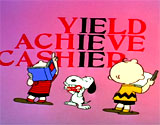 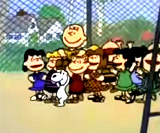 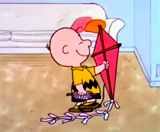 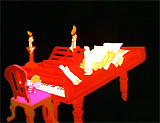 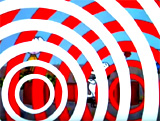 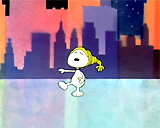
|
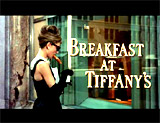
|
Breakfast at Tiffany's (1961)
George Axelrod's screenplay of Blake Edwards' romantic comedy was based upon Truman Capote's 1958 novella of the same name. The film had five Oscar nominations and won its two musical-related honors:
The one major musical highlight of this Paramount Pictures film was carefree Manhattan socialite (call-girl) Holly Golightly's (Oscar-nominated Audrey Hepburn) fire-escape rendition of the classic Oscar-winning tune Moon River (pictured). The plot told about the developing romance between Holly and her new neighbor, struggling writer Paul Varjak (George Peppard) with writer's block, although she was revealed to have an estranged husband, Doc Golightly (Buddy Ebsen). |
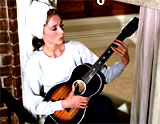
|
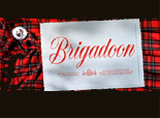
|
Brigadoon (1954) Director Vincente Minnelli's somewhat disappointing MGM musical (filmed on elaborate studio sets rather than on location) included many Lerner and Loewe hit songs, including:
|
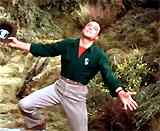 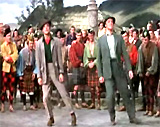 
|
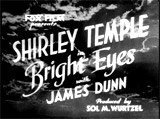
|
Bright Eyes (1934)
Curly-haired child actress Shirley Temple's (as orphaned Shirley Blake) star-making role for Fox Studios came with her first rendition of her classic and trademark signature song On the Good Ship Lollipop (pictured). It was performed to pilot/airmen buddies of her late father while she was dancing down the aisle of a prop plane that was taking off into the air:
|

|
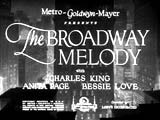
|
The Broadway Melody
(1929) (aka The Broadway Melody of 1929) An original score by the team of lyricist Arthur Freed and composer Nacio Herb Brown supported the Irving Thalberg and MGM-produced B/W musical 'backstage' story by director Harry Beaumont. This box-office success, MGM's first musical, was the first truly original all-talking movie musical (and the first to win Best Picture). It was the first in which the cast lip-synched to an already-produced soundtrack. Its success led to further examples of 'Broadway' musicals, 'backstage' stories, and other imitators. It starred Oscar-nominated Bessie Love (as aspiring performer Hank Mahoney), Anita Page as her sister Queenie Mahoney, and Charles King as successful song/dance man Eddie Kearns who won Hank's affections. It included the title number Broadway Melody (pictured) including tap-dancing by one of the chorines, the color sequence of The Wedding of the Painted Doll with the Zanfield Dolly Girls (pictured), the musical standard You Were Meant for Me, and George M. Cohan's Give My Regards to Broadway. |
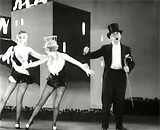 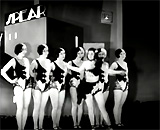 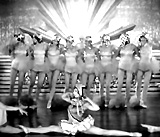
|
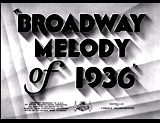
|
Broadway Melody of 1936
(1935) This was the second (and the best of four) of the "Broadway Melody" films that attempted to recall the Academy Award-winning Best Picture The Broadway Melody (1929) - MGM's first all-talking film. It was directed by Roy Del Ruth. The other two films were: Broadway Melody of 1938 (1937), and Broadway Melody of 1940 (1940). This 1935 production included Arthur Freed/Nacio Herb Brown songs that would be repeated in Singin' in the Rain (1952): I've Got a Feelin' You're Foolin', Broadway Rhythm, and You Are My Lucky Star. This musical starred Eleanor Powell (in her first MGM film) (as Irene Foster) with leading man Robert Taylor (as Broadway producer Bob Gordon), Jack Benny (as columnist Bert Keeler), and the dance team of Ted and Sally (Buddy Ebsen and his sister Vilma in their first film musical). Numbers included:
|
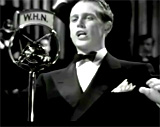 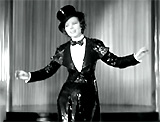 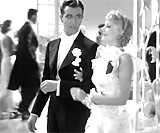 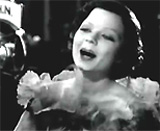 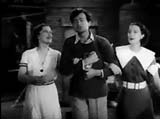 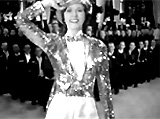
|
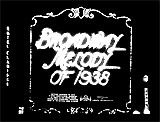
|
Broadway Melody of 1938 (1937) A young 15 year-old Judy Garland (her original name was Frances Gumm, in her first feature film appearance for MGM) sang and danced with Buddy Ebsen in this film. Her best-remembered, show-stopping song was You Made Me Love You (pictured) - poignantly directed to a photograph of Clark Gable ("Dear Mr. Gable..."). Her number overshadowed the rest of the film, including Eleanor Powell's heavily featured tap dance numbers, such as Follow in My Footsteps (pictured). |
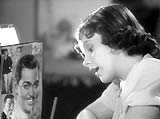 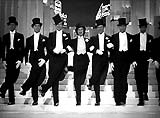
|
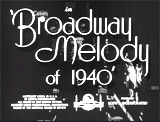
|
Broadway Melody of 1940 (1940) One of the most electrifying song-and-dance routines ever performed in film was in this musical (this one was filled with Cole Porter songs). It was the famous and sublime six-minute finale Begin the Beguine (pictured) between dancer Fred Astaire and Eleanor Powell, MGM's top musical star. |
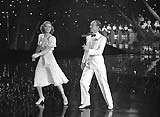
|
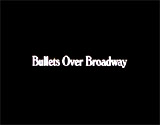
|
Bullets Over Broadway (1994) Woody Allen's Roaring Twenties-era show-business comedy included virtuoso chorus girl renditions of hit standards, such as:
|
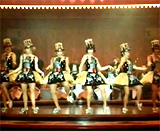
|

|
Would-be saloon singer Cherie (pronounced Cherry) (Marilyn Monroe) performed an off-key, inept, but innocently sensual rendition of That Old Black Magic (pictured twice) in the Blue Dragon - a run-down honky-tonk night-club in Phoenix. At the end of the number, she turned a red spotlight on herself to look "aflame." |
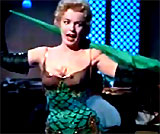 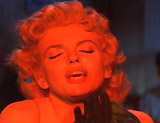
|
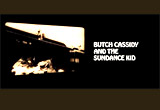
|
Butch Cassidy and the Sundance Kid (1969)
George Roy Hill's comedy-western featured only one lyrical musical interlude sequence. [Note: A comical-lyrical "Bicycle Ride" sequence was similar to a music video dropped into the middle of the film that had nothing to do with the film's plot.] In a memorable wordless, frolicsome bicycle scene, outlaw Butch Cassidy (Paul Newman) appeared outside a shack's window early one morning, riding a new-fangled bicycle of "the future." His voice, in the tone of melodramatic villains, intoned from outside:
Both Butch and the Sundance Kid (Robert Redford) were vying for the attentions of schoolmarm Etta (Katharine Ross), Sundance's girlfriend. Butch's disembodied head (with a Charlie Chaplin-like bowler hat) glided past the window. Etta rose and stood at the front door, where Butch gestured for her to get on the crossbar.
During the fun ride in the golden rays of the dawn's sunlight, Butch tried out the latest newfangled invention, and took her for a ride (on the handlebars) downhill to a old barn, where she watched his antics, accompanied by Burt Bacharach's contemporary smash hit, the award-winning original song: Raindrops Keep Fallin' On My Head (pictured) (sung by B. J. Thomas, and lyrics by Hal David). As she watched from the loft of the wooden barn, he performed acrobatic stunts on the seat and handlebars to impress her, and ended up ungracefully tumbling onto the ground in front of an angry bull. Afterwards, they rode off with Etta again precariously perched on the handlebars, and ended up arm in arm in a vast field, as the song concluded. |
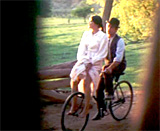 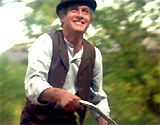 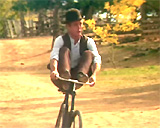 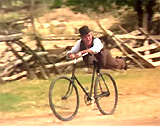 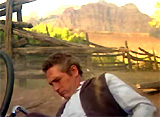 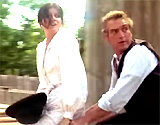 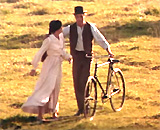
|
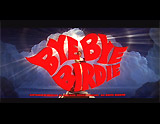
|
Bye Bye Birdie (1963) The Broadway hit show of 1960 was adapted for the screen by Irving Brecher and directed by George Sidney. It was the first Broadway musical to include rock songs. In its lampooning of rock-and-roll idol Elvis "The King" Presley, it told about an Elvis Presley-styled pop star named Conrad Birdie (Jesse Pearson). Dick Van Dyke reprised his role in the film as struggling songwriter Albert Peterson. He sang sang the memorable Put on a Happy Face (pictured) to his secretary-fiancee Rosie (Janet Leigh). 22 year-old Ann-Margret appeared in her third film as Kim McAfee - the lucky 16 year-old Ohio teenager who was chosen to receive a farewell kiss from the rock idol (before he was drafted into the military) on the TV variety program The Ed Sullivan Show. She sang the title song Bye Bye Birdie (pictured) at the film's opening in front of a blue-screen (and in a wind tunnel). Also memorable were:
|
 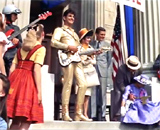 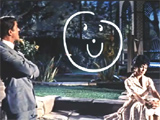 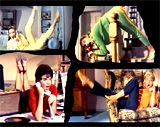 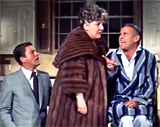
|
(alphabetical by film title) Introduction | A-1 | A-2 | B-1 | B-2 | B-3 | C-1 | C-2 | D-1 | D-2 | E | F-1 | F-2 | G-1 | G-2 H-1 | H-2 | I-J | K | L-1 | L-2 | M-1 | M-2 | N-O | P-1 | P-2 | R-1 | R-2 | S-1 | S-2 | S-3 | T | U-V | W | X-Z |